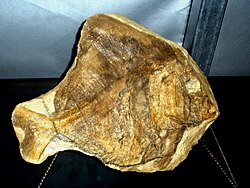Fossil content
Color key
| Notes Uncertain or tentative taxa are in small text; |
Cartilaginous fish
| Cartilaginous fish of the Agua Nueva Formation | ||||||
|---|---|---|---|---|---|---|
| Genus | Species | Location | Member | Material | Notes | Images |
| Aquilolamna | A. milarcae | Complete skeleton | A bizarre aquilolamnid shark. [3] |  | ||
| Lamniformes indet. | Articulated vertebrae | An indeterminate mackerel shark, potentially a cretoxyrhinid. [4] | ||||
| Ptychodus | P. decurrens | Vallecillo | Teeth | A ptychodontid shark. [5] [6] |  | |
| P. mortoni | Teeth | |||||
| P. sp. | Complete skeletons | |||||
| cf. Scyliorhinus | S. sp. | Articulated vertebrae | A catshark. [7] |  | ||
Ray-finned fish
Based on Amalfitano et al (2020): [8]
| Ray-finned fish of the Agua Nueva Formation | ||||||
|---|---|---|---|---|---|---|
| Genus | Species | Location | Member | Material | Notes | Images |
| Araripichthys | A. sp. | An araripichthyid. [2] |  | |||
| Belonostomus | B. sp. | An aspidorhynchid. |  | |||
| Clupeoidei indet. | Huehuetla | A relative of herrings. [9] | ||||
| Enchodus | E. sp. | Huehuetla | An enchodontid aulopiform. [9] |  | ||
| Goulmimichthys | G. roberti | Vallecillo, Huehuetla | A pachyrhizodontid crossognathiform. [2] [9] |  | ||
| Hastichthys | H. sp. | Huehuetla | A dercetid aulopiform. [9] | |||
| " Nursallia " | "N." tethysensis | Huehuetla | A pycnodont. [9] |  | ||
| Pachyrhizodus | P. caninus | A pachyrhizodontid crossognathiform. |  | |||
| Paranursallia | P. gutturosa | A pycnodont. |  | |||
| Rhynchodercetis | R. regio | A dercetid aulopiform. [10] |  | |||
| Tingitanichthys | T. sp. | A pachyrhizodontid crossognathiform. [9] | ||||
| Tselfatia | T. formosa | Huehuetla | A plethodid tselfatiiform. [9] |  | ||
| Vallecillichthys | V. multivertebratum | Vallecillo | A saurodontid ichthyodectiform. [2] [11] | |||
Lobe-finned fish
| Lobe-finned fish of the Agua Nueva Formation | ||||||
|---|---|---|---|---|---|---|
| Genus | Species | Location | Member | Material | Notes | Images |
| Latimerioidei indet. | Gular plate | A large-sized marine coelacanth, potentially Megalocoelacanthus . Originally interpreted as a cephalopod gladius and given the name " Palaeoctopus pelagicus". [12] | ||||
Reptiles
Mosasaurs
| Mosasaurs of the Agua Nueva Formation | ||||||
|---|---|---|---|---|---|---|
| Genus | Species | Location | Member | Material | Notes | Images |
| Yaguarasaurus | Y. regiomontanus | A plioplatecarpine mosasaur. [13] |  | |||
Plesiosaurs
| Plesiosaurs of the Agua Nueva Formation | ||||||
|---|---|---|---|---|---|---|
| Genus | Species | Location | Member | Material | Notes | Images |
| Mauriciosaurus | M. fernandezi | A polycotylid plesiosaur. [14] |  | |||
Molluscs
Cephalopods
| Cephalopods of the Agua Nueva Formation | ||||||
|---|---|---|---|---|---|---|
| Genus | Species | Location | Stratigraphic position | Material | Notes | Images |